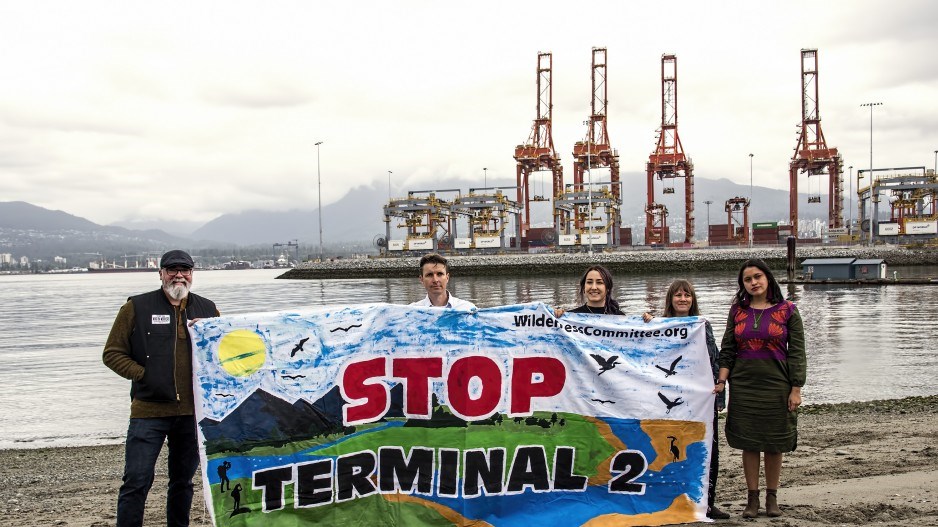It secured a federal government green light earlier this year after persevering through a decade-long planning and approval process, but the Â鶹´«Ã½Ó³»Fraser Port Authority’s ambitious $3.5 billion container cargo handling expansion project at Roberts Bank continues to draw fire from environmentalists, organized labour and other critics.
The latest anti-Terminal 2 rally, organized and endorsed by 14 organizations, including the BC General Employees' Union, International Longshore and Warehouse Union (Canada), the Georgia Strait Alliance and the Wilderness Committee, was staged this morning [June 14] at the Port of Vancouver’s Crab Park at Portside.
Its overriding theme, according to Rob Ashton, president of the International Longshore and Warehouse Union (Canada), was unity in opposition to a project that the speakers at the Crab Park event said would destroy an invaluable and irreplaceable marine estuary environment and eliminate thousands of high-paying port jobs.
Ashton told BIV that he had been listening to American rapper Eminem on the way to the Crab Park press conference.
“He has a good line in one of his songs: ‘We’re all in this together.’”
Ashton said that is the case now in the growing opposition to Terminal 2 as illustrated by the diversity of groups speaking out against Terminal 2 at the Crab Park event.
The employer class, he said, loves to split the working class into warring factions in a divide and conquer strategy.
But he pointed to representatives of environmental groups, First Nations, other unions and conservation groups at Wednesday’s event as evidence that there is now unity in Terminal 2 opposition.
ILWU opposition is focused on the and what Ashton said would be a fully automated terminal that would eliminate at least 3,000 high-paying dockworker jobs and accelerate the pace of automation at other B.C. container terminals.
Concerns over the potential environmental toll from Terminal 2’s construction and operation were delivered by Rueben George, from the Tsleil-Waututh Nation; David Bradley, director of Birds Canada; Lucero Gonzalez, a biodiversity campaigner for the Georgia Strait Alliance; and Charlotte Dawe, a conservation and policy campaigner for the Wilderness Committee.
DJ Pohl, the BC General Employees’ Union executive vice-president, underscored organized labour’s environmental and job elimination concerns regarding Terminal 2.
Plans for the Terminal 2 port infrastructure project include doubling the size of the current 85-hectare Deltaport container terminal with offshore landfill. Once completed and in operation, Terminal 2 will add an estimated 2.4 million 20-foot-equivalent units (TEUs) of container cargo handling capacity for the Port of Â鶹´«Ã½Ó³»and increase that overall capacity on Canada’s West Coast by 30 per cent.
The project received federal cabinet approval in April and can proceed subject to 370 legally binding conditions to protect the environment. It also still needs provincial government approval. But Terminal 2, which has been the target of controversy and criticism since it was first proposed back in 2012, could face another challenge after the Raincoast Conservation Foundation, the Wilderness Committee, the Georgia Strait Alliance and the David Suzuki Foundation filed .
Meanwhile, Tsawwassen and Roberts Bank area residents claim that the container terminal expansion will negatively impact bird and fish habitat.
They have also questioned the need for such a large expansion of container handling capacity in the Port of Â鶹´«Ã½Ó³»and the already congested Metro Â鶹´«Ã½Ó³»area when there are other options to expand that capacity incrementally in the region and at the Port of Prince Rupert.
But the VFPA has and continues to maintain that Terminal 2 will help maintain the Port of Vancouver’s ability to compete with rival ports in Mexico and the United States by providing Canada’s Asia-Pacific Gateway with the cargo handling capacity it will need for the expected increase in transpacific trade over the next decade.
Terminal 2, it estimates, will generate an estimated $3 billion in annual GDP, thousands of highly paid supply chain jobs in the long term and 18,000 construction jobs over the estimated six years it will take to build.
In response to the issues raised at the Crab Park press conference, Devan Fitch, the VFPA’s Roberts Bank Terminal 2 program director, said in a statement that the port authority’s focus “continues to be on advancing the project in a way that protects and enhances the environment, is reflective of Indigenous priorities and considers the needs of local communities. We are committed to Indigenous reconciliation, and proud of our close collaboration with Indigenous groups and our who have provided consent for the project.
He pointed to several key ways in which the VFPA aims to ensure Terminal 2 will be delivered in an environmentally responsible way. They include:
•continuing the VFPA’s collaboration with Indigenous groups, federal agencies, experts and stakeholders;
•mitigation measures to protect key species, including southern resident killer whales, chinook salmon and western sandpipers; and
•building 86 hectares (or about 567 hockey rinks) of offsetting habitat — developed in collaboration with Indigenous groups — to support priority species such as juvenile salmon and Dungeness crab.
twitter.com/timothyrenshaw



